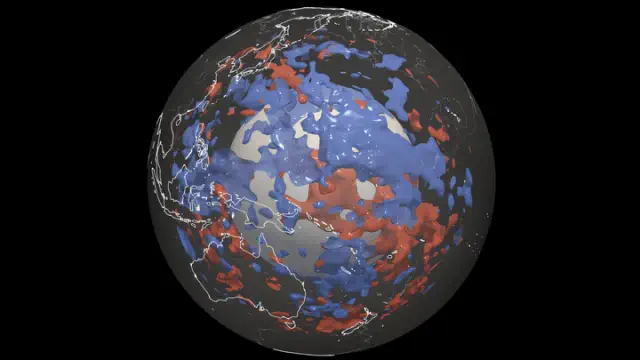(CNN) — Scientists have unearthed nearly 200 dinosaur footprints, dating back 166 million years to the Middle Jurassic Period, at Dewars Farm Quarry in Oxfordshire, England.
The extraordinary discovery, initially noticed in 2023 when quarry worker Gary Johnson detected “strange elevations” on the ground while mining limestone for roadwork, has been dubbed the “dinosaur highway” in reference to the vast trails created by these ancient beings.
Although various Jurassic pathways have been recorded around the world, the recent discovery of a "highway" in Oxfordshire stands out as the largest known dinosaur track site in the UK.
In June of this year, approximately 100 volunteers from the University of Birmingham and the University of Oxford came together for a week to excavate the site and meticulously document as much information as they could about the extensive area.
This discovery is especially noteworthy as it coincides with the 200th anniversary of the identification of the first dinosaur, the Megalosaurus, which was uncovered in Oxfordshire in 1824.
Kirsty Edgar, a micropaleontology professor at the University of Birmingham in England who participated in the excavation, stated, “This region has a rich history of fascinating dinosaur tracks and body fossils.”
The newly found tracks link to a dinosaur trail that was discovered in the same Oxfordshire quarry in 1997, although that area is now off-limits.
Nonetheless, as technology continues to progress, the newly discovered trackways will offer researchers the chance to examine information that was once inaccessible regarding these extinct species, revealing insights into their locomotion, feeding behaviors, and social interactions.
An ancient map of the past
During the excavation, scientists uncovered five extensive trackways, with the longest continuous pathway measuring more than 150 meters in length (492 feet), according to a University of Birmingham news release.
Four of these trails featured imprints from massive, long-necked, four-legged herbivorous dinosaurs classified as sauropods — most likely Cetiosaurus, which could grow up to 18 meters (59 feet) long, with the largest footprints measuring 90 centimeters (approximately 35 inches) in length, as noted by Edgar.
Lawrence Tanner, a paleoecologist and professor at Le Moyne College in Syracuse, New York, compared sauropods to contemporary elephants, emphasizing their enormous size and plant-based diet. He pointed out that the majority of the fossilized tracks were made by their hind legs, observing that, much like elephants, the hind feet of sauropods were considerably larger and frequently overshadowed the prints created by their front feet.
According to Tanner, who was not part of the excavation team, “The basic principle of locomotion is that as an animal increases its speed, the distance between its footprints also increases.”
The fifth pathway featured tracks left by the Megalosaurus, a large carnivorous dinosaur recognized for its unique three-toed feet. It is estimated that the Megalosaurus could reach lengths of up to 9 meters (30 feet), and researchers in Oxfordshire discovered footprints measuring 65 centimeters (2.1 feet) in length.
By analyzing the footprints, scientists were able to ascertain both the direction and velocity of the dinosaurs' movement. According to Edgar, the majority of these colossal creatures were heading northeast at an average speed of approximately 5 kilometers per hour (3 miles per hour), similar to a typical human walking pace.
Researchers suggest that larger theropods, like the Megalosaurus, did not possess the ability to run, in contrast to their smaller theropod relatives, which might have been capable of achieving high speeds. Tanner noted that the footprints left by this theropod indicate it was moving at a relaxed speed.
Scientists observed that the route of the Megalosaurus overlapped with the tracks left by sauropods, indicating that the predator traversed the region soon after the plant-eating dinosaurs.
Although it's challenging to determine the exact direction of the dinosaurs, Tanner suggested that they might have been moving along the coast to avoid obstacles like trees or in search of food.
Optimal conditions for preservation
The conservation of such a vast ancient pathway is uncommon and was facilitated by the distinctive environmental conditions present during the Jurassic Period.
The unique footprints suggest that the region was previously blanketed in soft sediment, with just the right amount of moisture to preserve the impressions.
Edgar likened the ancient environment of the site to that of the Florida Keys, noting its carbonate mud banks and the proximity of a water source.
According to Edgar, the tracks were swiftly concealed, probably due to a storm, which helped shield them from erosion induced by wind, water, or various animals.
Although discoveries of Jurassic bones frequently attract considerable interest, Edgar noted that dinosaur tracks offer more precise information about the lives of these long-gone creatures. In contrast to bones, which may be moved to various locations by natural forces like wind or water, as well as by scavengers, footprints are preserved in the exact spots where they were created.
Dinosaur tracks reveal not just the dimensions of these ancient creatures, but also offer insights into their behavior, including social interactions and predator-prey relationships. Tanner notes that if the tracks are well-preserved, they can provide valuable information on how these animals responded to shifts in their environment.
"It offers a glimpse into the daily life of the dinosaurs and their activities," Edgar remarked.
Envisioning upcoming breakthroughs
Throughout the excavation process, researchers documented over 20,000 images of the footprints using aerial drone photography. The team plans to utilize these images to develop intricate 3D models, enabling a deeper exploration of the interactions and biomechanics of the dinosaurs.
In the coming six months to a year, researchers will be focused on swiftly analyzing the gathered data and getting ready to share their results with the public.
"For the first time, we have these 3D models available, allowing anyone to explore the site and its history as soon as we make them public," Edgar stated.
Due to the constrained timeframe available for researchers to record the site and avert additional disturbances to the quarry, Edgar pointed out that a significant part of the surface has yet to be examined, which could hold even more insights into the various species that once inhabited the region.
“Edgar mentioned that as quarrying progresses, they will keep assessing and collaborating with the quarry workers whenever new sections are revealed. He expressed optimism about conducting excavations every summer.”










